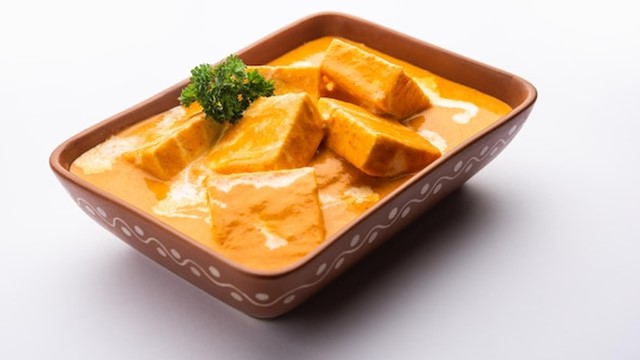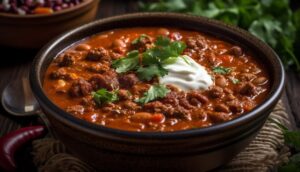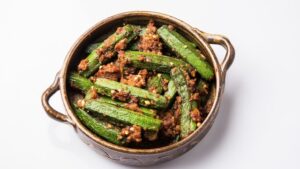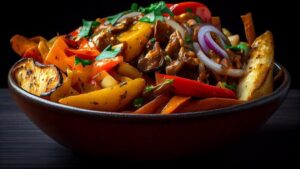Introduction
Shahi Paneer is a luxurious and flavorful dish that originates from Indian cuisine, specifically associated with Mughlai cuisine, known for its richness and elaborate preparation. The name “Shahi” translates to “royal,” signifying its association with royalty due to its richness and regal flavors.
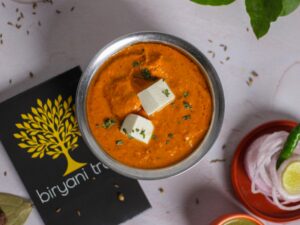
Key Components:
Paneer (Indian Cottage Cheese):
- Paneer forms the core ingredient of Shahi Paneer. It’s typically cubed and added to the rich, creamy gravy, absorbing the flavors while maintaining its delicate texture.
Creamy Gravy:
- The rich and velvety gravy for Shahi Paneer is prepared using a blend of tomatoes, onions, aromatic spices, cream, and sometimes nuts like cashews or almonds. This concoction is slow-cooked to create a luscious base for the paneer.
Aromatic Spices:
- Shahi Paneer owes its aromatic profile to a blend of spices like cardamom, cloves, cinnamon, and sometimes saffron, which impart a distinct fragrance and depth of flavor to the dish.
Regal root
- The “regal roots” of Shahi Paneer trace back to its association with Mughlai cuisine, a culinary tradition deeply intertwined with the Mughal Empire’s opulence and grandeur in India.
Mughlai Influence:
- Shahi Paneer’s origins can be linked to the Mughals, who were known for their refined taste in food, arts, and architecture. During their rule in India, which spanned from the early 16th to the mid-19th century, the Mughals introduced a distinctive style of cooking known as “Mughlai cuisine.”
Culinary Opulence:
- Mughlai cuisine was characterized by its lavishness, meticulous preparation methods, and the use of rich ingredients. It was developed in the royal kitchens, where master chefs (khansamas) crafted exquisite dishes fit for kings and queens, blending Persian, Central Asian, and Indian culinary traditions.
Creation of Shahi Paneer:
- Shahi Paneer emerged as one of the regal delicacies, born from the culinary prowess of these master chefs who catered to the discerning palates of the Mughal emperors and their courts. The name “Shahi,” meaning “royal,” denotes the dish’s association with royalty, signifying its indulgent and sumptuous nature.
Royal Flavors and Ingredients:
- Shahi Paneer exemplifies the grandeur of Mughlai cuisine through its use of luxurious ingredients such as paneer (Indian cottage cheese), cream, nuts, and a rich blend of aromatic spices. The dish was crafted to delight the senses, marrying a variety of flavors and textures to create a palatial dining experience.
Cultural Legacy:
- As a culinary legacy of the Mughal era, Shahi Paneer retains its status as a symbol of opulence and heritage. It continues to be revered in Indian cuisine, offering a taste of the royal extravagance that once graced the Mughal courts.
symphony of ingredients
The creation of Shahi Paneer involves a harmonious blend of ingredients, akin to orchestrating a symphony where each component contributes to the dish’s opulent flavors and regal essence.
Paneer (Indian Cottage Cheese):
Paneer, the star ingredient of Shahi Paneer, serves as the melody in this culinary symphony. Its delicate yet firm texture absorbs the creamy gravy’s richness while maintaining its own subtle taste, adding a luxurious creaminess to each bite.
Creamy Gravy:
The base of Shahi Paneer is a rich and velvety gravy crafted from a medley of tomatoes, onions, aromatic spices, and cream. This smooth and indulgent sauce envelops the paneer cubes, infusing them with a regal depth of flavor.
Aromatic Spices:
Much like the various notes in a musical composition, a blend of aromatic spices – such as cardamom, cloves, cinnamon, and sometimes saffron – intertwines to create a symphony of flavors. These spices contribute a fragrant and nuanced harmony, elevating the dish to a royal crescendo.
Nuts and Fragrance:
The inclusion of nuts like cashews or almonds adds a subtle nuttiness and a creamy richness to the gravy, akin to an orchestral undertone that enhances the dish’s luxurious character. Fragrant spices like saffron or rose water sometimes accentuate the flavors, infusing the dish with an exquisite aroma.
Simmering Technique:
The slow and patient simmering of the ingredients allows their flavors to intermingle and deepen, akin to the gradual building of a musical movement. This slow-cooking process ensures that each element contributes to the overall opulence and richness of Shahi Paneer.
Garnishing:
Just like a perfect musical piece culminates in a climactic finale, Shahi Paneer is garnished with a touch of fresh cream, chopped coriander leaves, or a sprinkle of nuts before serving. These finishing touches add a final layer of elegance, completing the harmonious culinary composition.
Universal appeal
Shahi Paneer, despite its regal origins and rich flavors deeply rooted in Indian heritage, possesses a universal appeal that transcends cultural boundaries. Its allure extends beyond India, captivating the taste buds and hearts of food enthusiasts worldwide. Here’s an exploration of its universal appeal:
Flavor Profile:
The decadent and creamy texture combined with a well-balanced blend of aromatic spices in Shahi Paneer offers a flavor profile that intrigues and satisfies diverse palates. Its rich, yet not overpowering taste, makes it accessible and enjoyable for a wide range of taste preferences.
Culinary Diversity:
In a global culinary landscape where diversity reigns supreme, Shahi Paneer stands out as a versatile dish. Its adaptability allows for variations in spice levels, creaminess, and even the incorporation of alternative ingredients to cater to different dietary preferences or restrictions.
Vegetarian Delight:
As a vegetarian delight, Shahi Paneer serves as a substantial option for those seeking meatless alternatives without compromising on flavor or satisfaction. Its protein-rich paneer content provides a fulfilling dining experience.
Cross-Cultural Integration:
The embrace of Indian cuisine in various parts of the world contributes to Shahi Paneer’s global popularity. Its presence in Indian restaurants globally, fusion food trucks, and adaptation in home kitchens fosters cross-cultural integration, inviting individuals to savor a piece of India’s culinary heritage.
Culinary Fusion:
The versatility of Shahi Paneer allows for fusion interpretations. Chefs and home cooks often experiment with innovative twists, incorporating local ingredients or culinary techniques, creating fusion versions that appeal to diverse tastes while retaining the essence of the dish.
Appreciation for Richness:
Across cultures, there exists an appreciation for rich and indulgent flavors. Shahi Paneer’s opulent and creamy texture resonates with those who relish dishes that evoke a sense of luxury and comfort.
Global Accessibility:
With the availability of ingredients and recipes through various online platforms, cookbooks, and cooking shows, Shahi Paneer has become more accessible globally, enabling individuals to recreate this royal dish in their own kitchens.
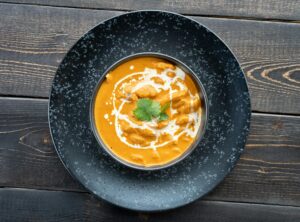
Recipe
Here’s a basic Shahi Paneer recipe that you can try at home. This recipe serves as a starting point and can be adjusted based on personal preferences:
Ingredients:
- 250 grams paneer (Indian cottage cheese), cut into cubes
- 2 tablespoons ghee or oil
- 1 large onion, finely chopped
- 2 tomatoes, finely chopped or pureed
- 1-inch piece of ginger, grated or minced
- 2-3 garlic cloves, minced
- 1 green chili, finely chopped (adjust to taste)
- 1/2 cup cashews, soaked in warm water for 15-20 minutes
- 1/4 cup cream
- 1 teaspoon red chili powder (adjust to taste)
- 1 teaspoon coriander powder
- 1/2 teaspoon turmeric powder
- 1/2 teaspoon garam masala
- 4-5 strands of saffron (optional)
- Salt to taste
- Chopped coriander leaves for garnish
Preparation:
- Heat ghee or oil in a pan on medium heat. Add chopped onions and sauté until golden brown.
- Add minced garlic, grated ginger, and chopped green chili. Sauté for a couple of minutes until the raw aroma disappears.
- Add chopped tomatoes or tomato puree. Cook until the tomatoes soften and the mixture thickens.
- In a blender, make a smooth paste of soaked cashews by adding a little water if needed.
- Add the cashew paste to the pan and mix well with the onion-tomato mixture.
- Add red chili powder, coriander powder, turmeric powder, garam masala, and salt. Mix the spices with the gravy and cook for a few minutes.
- Pour in the cream and mix thoroughly. If using saffron, dissolve it in a tablespoon of warm milk and add it to the gravy for enhanced flavor and color.
- Add the paneer cubes to the gravy and gently stir to coat the paneer with the sauce. Simmer for 5-7 minutes on low heat, allowing the flavors to blend.
- Once done, garnish with chopped coriander leaves.
Serving:
Serve Shahi Paneer hot, garnished with fresh coriander leaves, alongside naan, roti, or steamed rice.
Feel free to adjust the spices, cream quantity, or consistency of the gravy according to your taste preferences. Enjoy creating this delicious Shahi Paneer dish at home!
Lorem ipsum dolor sit amet, consectetur adipiscing elit. Ut elit tellus, luctus nec ullamcorper mattis, pulvinar dapibus leo.

